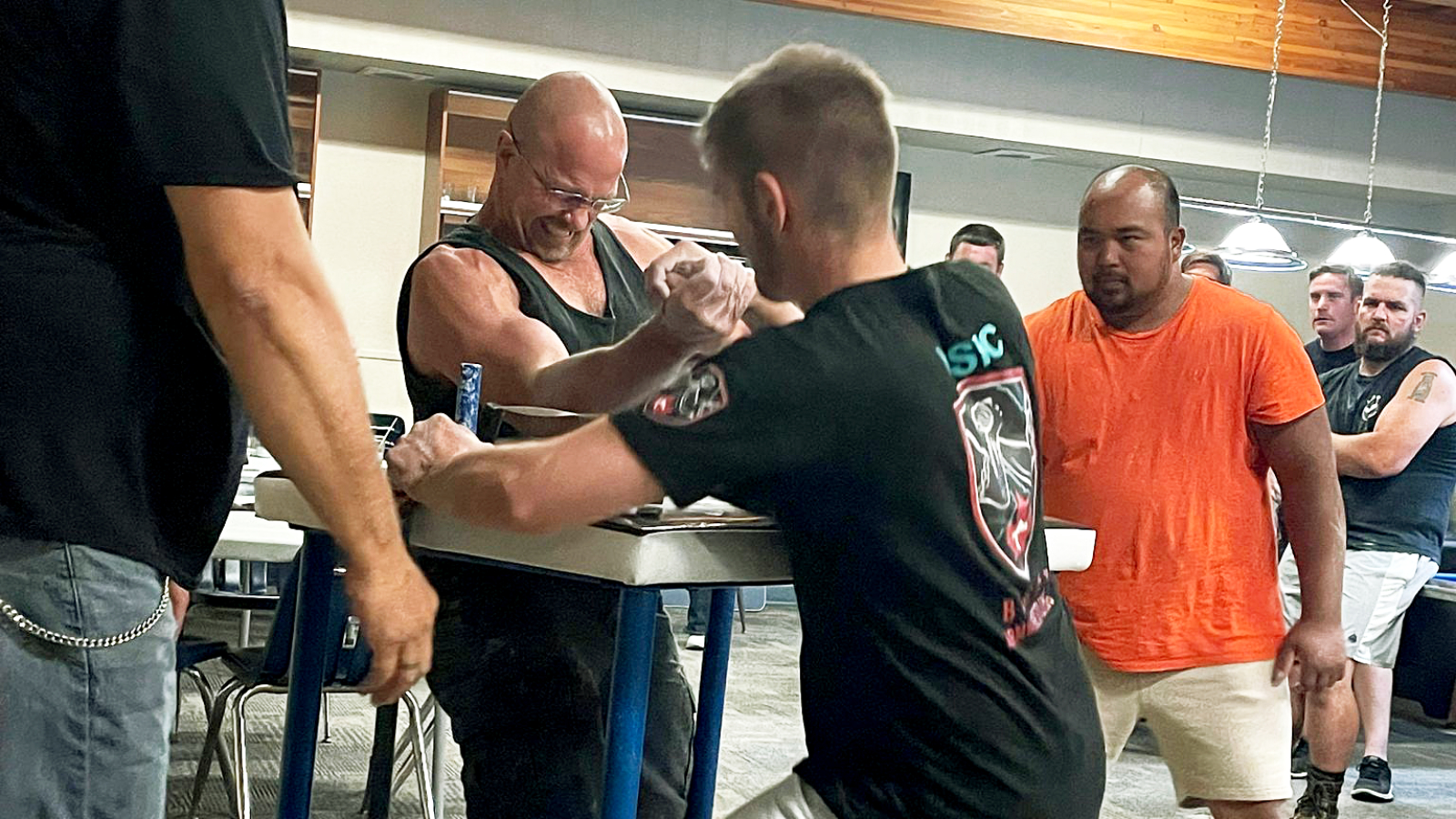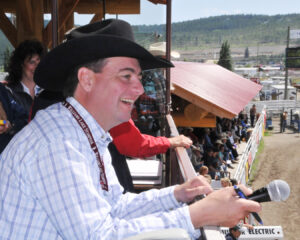On your marks, get set, arm wrestle!
Saturday, July 10 the Buggy Armwrestling Club hosted an amateur tournament in town. Dalibor Bagaric, who is the president of the club, hoped to bring awareness to the sport and to get more people involved through the tournament. Bagaric and his son and daughter are certified arm wrestling referees through the Canadian association. When hosting amateur events they take extra care for safety.
“We don’t want anyone to hurt themselves so we will show them the proper way to do it and the safe way,” says Bagaric.
Bagaric is originally from Croatia and moved to Canada in 2013. In Croatia, Bagaric was involved in martial arts and once he moved here he was looking for another similar sport to get involved in, this is when he discovered arm wrestling. The Buggy Armwrestling Club began five years ago in Drayton Valley but unfortunately Bagaric and his family ended up moving away for three years. They have since returned and are ready to bring the sport back.
Buggy Armwrestling Club is a member of a larger league called Stronghold Arm Wrestling out of Thorsby, which is the only league within Alberta. The league and club have many tournaments including their main event coming up in August which will include belts for the champions.
In January 1965, the St. Anthony School opened its doors. Now, 60 years later, the school is planning a celebration of the milestone.
Principal Janelle Molzan says they are planning to have a celebration on May 24 at the school gym. They will be using the event to also fundraise for the school.
Molzan says they will have a band performing that evening, catering from a local restaurant, a full cash bar, as well as some door prizes.
Part of the celebration will also be the fact that St. Thomas Aquinas Roman Catholic School Division has put St. Anthony at the top of their priority list for a new school. Molzan says the division has to wait until next year to submit their request to the Province, and there is no guarantee that they will be selected for funding.
“It could be anywhere from two to ten years,” she says. “Or more.”
However, she feels that St. Anthony has a strong case for asking for a new school.
The most recent remodel of the school was in 1992, says Molzan. At that point they expanded the school, removing the gym from the centre of the school and installing classrooms instead. The new gym was then built as an addition to the school.
“We had the addition of the gym as well as a few classrooms in 1992,” says Molzan.
Since then, there have been no major remodels or renovations. Instead, the staff have been doing what they can to keep the building in shape.
“It’s a really well built school,” says Molzan.
She says over the years, the natural heaves and settling that occur with temperature fluctuations has led to some cosmetic damages to the building. “It’s just showing its age,” she says.
While the school is starting to show wear, Molzan says there are no capacity issues. About 15 years ago, the school went from being a K-12 school to a K-8 school when the Holy Trinity Academy was built.
Molzan says if they don’t get a new school they will have to pursue getting more renovations or remodeling for the current building.
New trespassing program helps businesses
Businesses will now have another option for dealing with trespassers thanks to a new program that Enforcement Services have put into place.
Cody Rossing, the manager of enforcement services and emergency management for the Town, says one of the biggest challenges for businesses in the community who were issuing trespass notices is that someone has to attend court in order for the trespassing charge to stick. With the new Trespassing Agent program which comes into place on March 20, businesses who enrol will not have to attend court.
Previously, businesses who contacted the RCMP to report a trespasser had to issue the trespass notices themselves.
For many businesses the process didn’t work well. Larger franchises, like banks, found arranging the issue of a trespass notice and attending court was not logistically feasible. Small business owners, on the other hand, could issue the notice but may have to close their business in order to attend court.
Rossing says there are two different pieces of legislation that speak to trespassing, the Petty Trespass Act and the Trespass to Premises Act.
“Under both of the legislations, the property owner or their agent are required to provide trespass notices, help get people off of their land, and stuff like that,” says Rossing.
The first offence fine under the provincial legislation is normally $600, but it could be up to $10,000. A second offence could have a fine of up to $25,000
The higher fines come into place when the individual ignores the notice and returns to the property. If the trespasser returns three times, the officers can then issue a summons to court. If they fail to attend, a warrant is issued, and at that point if they are found guilty, the higher fines can be given.
Rossing says the program is helping streamline the process for businesses. If they choose to enrol in the program, it will allow peace officers or the RCMP to act as their agent and issue the notices. It also means the business owners won’t have to attend court.
“Court is scary for a lot of people, and we understand that,” says Rossing.
The purpose of the program is to improve the process because officers are continuing to get calls to the same place over and over and business owners or their employees are uncomfortable with the court process. Until now, there hasn’t been any way to address those issues.
“It’s been a lot of work on the back end because there is no follow up process in place and there is no trespass notice being issued,” says Rossing.
He says the hope is that by having this program in place, businesses can sign up and they can begin to address the issue more efficiently.
Several different municipalities in the province have a similar program in place, says Rossing. While developing the program, Rossing did research on other initiatives and reached out to other municipalities that had something similar in place. He says he wanted to be sure that he had everything in place before he announced the program in the community.
There are also checks and balances that have been worked into the program.
“If you’re trespassed from a local business, one of our officers shows up and says you’re trespassed for six months, if you don’t agree with it, you can appeal that process,” says Rossing.
He says there is also the option for the business owners to speak with the officer and reduce the amount of time the individual is trespassed for. In some cases, if the RCMP issue a notice that’s in effect for six months, a business owner may come forward and advocate for the trespasser if the individual doesn’t normally behave in that manner
“They can say, ‘This person is normally a good customer, but there is something going on with him right now. I think maybe a month would be more appropriate,’” says Rossing.
However, it is ultimately the final discretion of the officer.
Once a business is enrolled in the program, they will receive a sticker that they can place in a conspicuous area that is easily visible for officers. If they receive a call, the officer will know that they can issue the notice themselves rather than speaking to the owner and explaining the process that has to take place.
Rossing says enrolment in the program is free, and he encourages businesses to sign up if they are having consistent issues with people loitering or being a nuisance on their property. Those who are interested in enrolling can visit www.draytonvalley.ca/enforcementservices/trespassingagent and fill out the form. They can then email it in to enforcement@draytonvalley.ca or drop it off at the Town office.
Technology bring collisions into focus
There are approximately 187 accidents in town each year within Town limits. That’s according to data from Drayton Valley Enforcement Services.
Cody Rossing, the Manager of Enforcement Services and Emergency Management for the Town, says data from 2016-2023 has helped map out intersections in the community that sees the highest number of collisions. The intersection at 50 Street North and Hwy 22 has had eight collisions, the highest in the community. The second highest number was at the intersection of 50 Street and 50 Avenue.
“Anything along Highway 22, the Town doesn’t have jurisdiction over, pertaining to road designs or changes,” says Rossing.
He says getting the data from the Province regarding collisions along Highway 22 is something they haven’t been able to do before. Now that they have the data they can start mapping out the high incident intersections and starting brainstorming ways they can address some of the problem areas. Rossing says those areas will have more focus from the community peace officers.
Rossing says they are trying to develop strategies on how to reduce collisions in the community on a whole, particularly those that result in fatalities.
“There’s different things we can use like engineering and controls,” says Rossing. “But for enforcement services, how are we strategically educating and enforcing in those areas?”
He says there are a number of factors that can contribute to collisions. Over the past eight years there have been 434 caused from unsafe speeds, 245 were intersection related, 163 that are weather related, 114 from road surface conditions, 51 involving animals, and 417 were from drivers performing improper actions.
With speed being the most prominent cause, enforcement services have been taking action to find out where speeding is most common and increasing patrols. The digital speed signs that were purchased with funds from the Community Safety Committee don’t have cameras on them, but they do record the speed and report that data back to enforcement services.
On March 6, officers intercepted a vehicle driving 102 km per hour in a 50 km zone.
“That vehicle was pulled over, a court summons was issued to the driver to compel them to court. If they don’t attend court a warrant will be issued for them,” says Rossing.
If they are found guilty, they could face a fine of up to $2,000 and/or a license suspension.
Rossing says anyone who is over the speed limit by more than 51 km per hour will face an automatic court summons.
This was not the only incident of speeding. On March 5, the digital speed signs picked up on a vehicle driving 111 km per hour in a 60 km per hour zone. They also pulled over a vehicle going 50 km per hour over the limit that same day.
“That is strictly within the Town of Drayton Valley boundaries,” says Rossing.
There are a number of reports enforcement services can get from the digital signs, including the amount of traffic on a road and the times that see the most traffic. Using this data, enforcement services can ensure they deploy units during the busiest times of the day to the areas where speeding is common.
What you see is what you get
Like William Shatner, Mike Myers, Wayne Gretzky’s dad and God help us, Celine Dion, here at the Free Press, we are Canadian.
There’s been a lot of talk recently about US ownership of some of this country’s most prominent businesses and institutions. At the Free Press we are certainly not prominent, nor do we want to be institutionalized. But still, it seems like a good time to point out to anyone who’s interested, that we are exactly what we appear to be.
We are 100 percent locally owned. There are no hidden shareholders or outside interests. All of our staff live in either Drayton Valley or Brazeau County, apart from our designer, Brittany. She’s from here, but currently telecommutes from somewhere in British Columbia, which I have to confess, makes me a little jealous sometimes.
What else can I tell you? The Free Press is printed for us by some nice people in St. Albert. The printing press is owned by Great West Newspapers, which is also a Canadian company.
The paper we’re printed on comes from the Alberta Newsprint Corporation in Whitecourt. Incidentally, the paper is made from offcuts and waste from the lumber industry so we’re not cutting down trees to make the paper.
Once the paper has been printed it’s picked up and brought back to town by Drayton Valley’s own Rocket Express. At that point it’s back to us as we deliver it throughout the community.
Now you may be wondering why I’m telling you all this. Would the Americans really be interested in owning a tiny little paper in a small town in Alberta?
Well, you’d be surprised. A good chunk of Canada’s print media is currently in American hands, and that includes a number of community newspapers in this province. Postmedia is 66 percent owned by Chatham Asset Management, a hedge fund based in New Jersey. Who are Postmedia? They are the owners of the National Post, the Calgary Herald, the Edmonton Journal, the Calgary Sun, the Edmonton Sun and a host of other newspapers, both large and small, from coast to coast.
That situation may not be quite as bad as it sounds. I was the editor of the Drayton Valley Western Review (kids, ask your grandparents) for 10 years. During my time there the paper was owned by a succession of large, soulless corporations based in central Canada. They did absolutely nothing to impact the way we covered the news. I barely heard a peep in over a decade. I always suspected that was less to do with high journalistic standards at corporate headquarters, and more down to the fact they were only dimly aware we existed and probably couldn’t find Drayton Valley on a map, but either way the effect was the same.
So corporate ownership, whether it’s American or not, probably isn’t the best thing ever, but it isn’t necessarily fatal to Canadian news.
But I do think there’s an important distinction between a paper like the Free Press and some of the others; and it’s this. If you take out a subscription or buy an advertisement with us you can be confident that your money is staying close to home. And especially these days, that seems like a good investment.
Local auctioneer takes the championship
A local auctioneer has chanted his way into the history books after securing himself a first place position at the 2025 Canadian All Around Auctioneer Championship.
Prior to the 2025 CAAAC, Justin Mayer had already earned a trophy at the 2020 Canadian Bid Catching Competition. He is the first to hold a title for both competitions.
Mayer, at 29-years-old, says he’s been participating in the CAAAC for more than a decade. His mentors and many of the auctioneers he grew up listening to have all competed in the competition and some have won.
“It’s a pretty prestigious award,” says Mayer.
A good auctioneer is someone who can present themselves in a professional manner, with confidence in your body language and hand gestures. They have to be well spoken and comfortable with public speaking. The auctioneer chant, which requires rhythm, clarity, and speed to be considered such, is also an important technique that auctioneers must master.
“You should be able to almost dance to an auctioneer’s chant,” says Mayer
When he entered the CAAAC, Mayer participated in two rounds. The preliminary round ruled out everyone except for the top five. Those five then moved onto the final round.
In both rounds, five judges ranked their skills on a scorecard, and the person with the best overall ranking took home the award.
Mayer is not the first member of his family to take home the CAAAC title. His uncle Ron Sekura also held the title, and for Mayer, that makes the win even sweeter.
“He’s passed on, so it’s pretty cool for me to have the title with him,” says Mayer.
As a kid, Mayer was surrounded by some of his biggest mentors in the auctioneering world. His uncle, stepfather Corey Sekura, and grandfather, Wendell Sekura, all encouraged his love of auctioning.
He says he loves the sport because of the high energy atmosphere and the chance to meet people.
“When you’re up on the stand in front of the crowd selling, it’s up to me to present, in lots of cases, people’s livelihoods and their entire life, whether you’re selling a farm or a disbursement sale. It’s up to you, as the auctioneer, to generate excitement and do your homework in front of the crowd in order to bring top dollar for people,” says Mayer.
Over the years, Mayer has met many people and he says he enjoys the connections
“I know somebody from every town,” he says.
Now that he’s taken the title for the CAAAC, he is eligible for the International All Around Auctioneer Championship and from there he can head off to the World Championship.
For many, the decision to go to the international championship would be easy, but Mayer says he’s not sure what he’s going to do.
“I grew up in an auction family, and for me and my family to win this competition was a big deal,” says Mayer. “Now that I’ve won it, I kind of feel like I achieved what I wanted.”
However, Mayer has been receiving encouragement from Rob Bergevin, a Canadian International and Worlds competitor, to go to the International Championship.
“I beat him this year and he’s really trying to convince me to go to the International because he thinks I have a shot at it,” says Mayer.
Mayer’s love of auctioneering resulted in him going to Western College of Auctioneering in Billings, Montana in 2013. Since then, he’s been building up his reputation as an auctioneer across Alberta and British Columbia.
He says his uncle and stepfather were always in his ear, pointing out areas where he could do better and giving him advice to improve his skill.
“Grandpa Wendy was a big factor in that as well,” says Mayer.
For several years, Mayer spent a lot of time travelling to municipalities across the province and British Columbia to local auctions. However, once the pandemic hit, many auction houses opted for online auctions as a way to still run the business while meeting government regulations. Since that time, it’s not uncommon for auctions to be held online.
“But I still travel around,” says Mayer. “I still do lots of auctions. I’m never going to stop. It’s too exciting.”
Over the years, Mayer has worked for Team Auctions, as well as auctioning off classic cars. He also works for a lot of charity auctions.
When his children were younger, they struggled with the amount of time that Mayer was away. Now that they’re older, he says they appreciate it more. His daughter has even been asking for lessons, and has been practicing reading off a list of numbers that she has on her wall.
Mayer says he’s grateful to everyone for their support and encouragement over the years.
“I’m tremendously thankful to my mom, my dad, the Sekura family, my wife and my kids. They have all been there for me. They’ve all shaped me,” says Mayer. “Probably my biggest influence in all of it was my Uncle Ron, and my dad, Corey. They really shaped me and supported me.”
Charter school proposal moving forward
Members of local indigenous groups are working toward opening a charter school with the goal of offering students an education that goes beyond academics.
Charlene Bearhead, a member of the board for the Roots of Resilience not-for-profit society, says the group is applying to the Minister of Education to be able to open a charter school in Drayton Valley, with a goal of opening in September.
The society is hosting an information night on February 13 from 5-7:30 p.m. at the Holiday Inn Express.
Bearhead says her 40 years of working in education has made it clear that the system is failing children and staff as human beings.
“I’m always a big believer in doing the best you can to try to work with what exists already and do what you can to help guide that,” says Bearhead.
She worked within the system, and recently served as a school board trustee, but she says people weren’t ready to progress with changes she feels need to be made.
The goal of opening the charter school is to offer a learning experience that encompasses a child’s entire wellbeing, including mental and spiritual health, along with teaching Alberta’s curriculum. While the students will learn from methods that indigenous people have always used for passing on knowledge, Bearhead says the school isn’t just open to indigenous children. Any child in the area from Kindergarten to grade 12 will be welcome to attend.
One thing that Bearhead wants the public to be aware of regarding charter schools is that they are still public schools. Roots of Resilience will be funded in the same manner that Wild Rose School Division and the St. Thomas Aquinas Roman Catholic School Division are.
“One lady said to me, ‘This sounds so amazing Charlene, but I really struggle with anything that takes away from public schools,’” says Bearhead. “I had to say to her ‘This is public education. This is public school.’”
She says there are only provisions for charter schools in Alberta. Charter schools receive the same funding for facilities, transportations, and other expenses, and the same requirements to follow the Alberta curriculum and the Education Act. Just like any other public school, parents do not have to pay extra to enrol their children in a charter school.
“But they are intended to be schools of choice,” says Bearhead. “They give parents and kids a choice in their education.”
However, charter schools are not without controversy. According to the website of Alberta Teachers’ Association, “there is only one pot of money for schools in Alberta. When money is diverted to private and charter schools, it leaves public schools in a funding shortfall.”
Bearhead says charter schools have to offer a unique approach to education that isn’t available in the geographic area. Bearhead says it’s important to the RoR society to define the holistic success for the school, which means the students will be doing better in body, mind, and soul, as well as academically.
She says that pushing people hard to do well academically while ignoring all other aspects of the student’s progress doesn’t work well. For Bearhead, it’s important for educators to meet the students where they’re at, value them as human beings, offer them a safe environment, and offer opportunities for the students to see themselves reflected in what is being taught.
Along with the regular curriculum, Bearhead says they plan to offer language programs for those who are interested in learning the language of their ancestors to help those students connect with their heritage.
Wendy Snow, the Interim District Captain in the Otipemisiwak Metis Government for District Eight and member of the RoR society, says she feels her own children would have benefitted from what the proposed school will be offering.
Snow says she has two children as well as a niece that she is the guardian of. With all three of them going to school in Drayton, she says they went to almost every school in the community.
“I found that it was very lacking as far as teaching to our culture,” says Snow.
She says every year she would fill out the demographic forms, indicating that her children were indigenous, knowing that the school division would get additional funding for those students.
“I found that all of the funding in the Wild Rose School Division went to Rocky Mountain House,” she says. “All the programming, all the culture stuff, everything went to Rocky Mountain House.”
Like Bearhead, Snow wanted to work with the system and try to help improve things. She ran twice for school board trustee, but did not get elected.
“I’ve always wanted to see more funding and programming and culture stuff in this area, just like there is in Rocky Mountain House,” says Snow.
Bearhead says the RoR school will resonate with indigenous children.
“An indigenous pedagogy, or approach to education, is about physical, mental, social, emotional, and spiritual [well-being]. Whatever that means to you. Everyone is indigenous to somewhere,” says Bearhead.
She says public charter schools are smaller and have unique approaches to education.
“They are actually intended to be models for how education could happen in any or all public schools,” she says.
Bearhead says when the students see themselves reflected in the content they’re learning, they have a better chance of relating to it and absorbing it.
By making the students the centre of the system, educators can focus on the whole child, not just the content they’re supposed to be learning. She says each student has different strengths, weaknesses, interests, and paths. In their school, they plan to help students excel at their strengths, offer support for their weaknesses, and encourage their interests and plans.
Another important part of education is offering the students a safe space.
“If kids are terrified, if kids are being bullied, if kids don’t feel safe, how can they focus on learning?” says Bearhead. “That’s just human instinct. That’s survival.”
She says if students are feeling ostracized, alienated, or left out, it’s more challenging for them to learn.
Roots of Resilience will also offer hands-on learning for students. This experiential learning will be land-based, which means there will be more of a balance between indoor and outdoor learning. She says there are many different areas of the curriculum that can be taught outdoors beyond science and physical education.
“For me, when you do something, rather than just read about it or hear about it, it becomes ingrained in you,” she says.
Snow says she wants to see children in the area have an opportunity to choose an education that best suits them.
“I think it just gives them a great basis for success later on in life,” says Snow.
Bagaric is hoping the sport of arm wrestling will catch on in Drayton Valley and this was the main inspiration for hosting last weekend’s event.
“My wish is to get people from here to learn more about arm wrestling because this is our hometown,” says Bagaric. The event was originally set to take place in the White Bull parking lot but unfortunately had to be moved last minute to the legion as a result of high winds. People showed up from across the province including Calgary, Lethbridge, Airdrie, Red Deer and Edmonton. There were around 30 competitors and 50 spectators. Bagaric says numbers of attendees were reduced due to weather conditions. At the end of the day Jeremy Estey from the Lethbridge arm wrestling club took first place for left and right arm in the lightweight and mid weight category and Shawn Crowthers out of Red Deer took first place for left and right arm in the heavyweight category.
Businesses will see some changes to the local Rural Renewal Stream program come into effect on November 13.
The program, offered through the Alberta Advantage Immigration Program, allows business owners to bring in skilled workers from outside of the province or country. It also allows business owners who employ staff on a Temporary Work Visa to endorse them for permanent residency through the program.
At the October 30 town council meeting, Kundiso Nyambirai, the growth services manager, explained that they had 300 applications that they were reviewing. Between March 2023 and August 2024, the Town had endorsed 200 of those applications for consideration to the Province.
Nyambirai explained that the Province has now put a system into place to make it easier to sort through the applications on their end.
The points based system gives a better idea of which applications are most likely to be considered or approved for those municipalities endorsing them. Nyambirai says his department is reviewing the applications to see which ones would have enough points to be considered by the Province.
However, the Province is limited in the number of applications that it can put through. There are more than 70 municipalities and districts participating in the program, and the Province only has 1,900 spots they can approve in 2024.
“We are over-subscribing,” says Nyambirai. “We are endorsing 200 plus people.”
In August, the Town decided to make some changes to the way that the program would work in the community. This included limiting the number of applications to 100 each year, while also limiting the number of applications a business can submit to five. Nyambirai also suggested that limiting applications to workers who already resided in the community could help to ensure that the Town does have housing available for these applicants.
Nyambirai says the Province is currently sorting through 1,000 applications to decide on the remaining spots for the year. Councillor Monika Sherriffs agreed that the Town is sending in a higher than average amount of endorsements, stating that if there are 1,000 being considered and Drayton Valley has sent in 200, then we would be sending in many more applications than other municipalities.
Councillor Amila Gammana disagreed, saying that he believed other communities are likely doing the same. He says the real question is how many of those endorsements are receiving approval from the Province.
Nyambirai says that the municipalities are not made aware of which endorsements are approved. He says that looking into that number by contacting applicants would be very time consuming, so they cannot be sure how many of Drayton Valley’s businesses’ applications have been accepted for the program.
Sponsored Content
In the age where there’s a constant drive for more and more content, coming up with ideas of how to promote your business can become a full time job on its own. I mean – you signed up to be a business owner right? Not a videographer, copywriter, or graphic designer. The good news is print advertising works differently from the social platforms that have you constantly chasing the next batch of likes and shares.
Print advertising with your local newspaper gets you off the hamster wheel and connects you with a copywriter, graphic designer, and an ad planner who are actually interested in learning the ins and outs of your business. This person or people will work with you to generate creative ideas within your marketing budget. With their help you can get your creative juices flowing again and find ways to not just push content but to craft creative content that will be seen and prompts action.
Print ads are consumed like fine wine. Readers look at print ads longer and deeper than they do the disruptive advertising found on other media platforms. Tell me in the last time that you’ve binge scrolled your social media feeds – How many ads do you actually remember seeing? I am betting, not many.
Print ads are non-disruptive content for newspaper readers and therefore get the attention they truly deserve. They have a longer lasting impact for readers, and after all, deepening the relationship with customers is really what you are looking to do.
So here are some ways you can position your local business with print advertising.
- Thought leadership: Be a thought leader in the regional landscape of your industry. Use an ad space for how-to content, data presentation on regional trends. Newspaper readers are readers and so are more likely to read long form advertisements with interesting information. You can reuse this information on your website blogs, social platforms, podcasts and the like.
- Be action oriented: Ads are there to move the needle forward. A call to action can be as simple as moving an interested person from the print ad to “Check out our online store” – print to digital is easy to do in both the print and digital formats of your local newspaper. Using click through options and QR codes to specific URLs makes the cross over from print to digital platforms seamless.
- Event marketing: Discovering local events in the community newspaper is one of the top interest points for local readers. But don’t just churn out a generic “Come to our event”. Remember our readers enjoy spending time with the paper. Capitalize on that. When you advertise an event in the newspaper you have an opportunity to make an intimate connection so don’t treat it like a fly by night ad. Make it engaging, personal, and relevant.
- Coupons and promotions: If you are a retailer or a restaurant that has deals and promotions, newspaper readers take notice! Not only does the use of coupons help you track the effectiveness of your ad it also gets people in the door where you can start to deepen your client relationship.
- Minimize or maximize. When people book a print ad they tend to want to throw everything into it. This creates a cluttered, hard to read ad. Instead take the space to promote your one product or service that tends to get people in the door, then cross promote once you are in contact with your prospective client. Alternatively you can also use the space to create an organized product catalogue, or flier page that showcases a number of products but in an organized and thematic fashion.
By contacting your local newspaper you don’t just get an ad, you expand your marketing team exponentially. You get access to our professionals and we help you to figure out the direction you are looking to go with your business.
One local youth has seen his hard work with 4-H pay off after being selected as one of 12 youth to show their steers at the 2025 Calgary Stampede Junior Steer Classic.
Hunter Harris is a third generation 4-H member and has been part of the organization since he was 12 years old. Not only does he show cattle for 4-H, he’s also been entering open shows for the past two years. He says showing cattle is just a natural extension of his life as the son and grandson of farmers.
“I think it’s really important to know where your food comes from and I really enjoy showing,” says Harris. He says he also feels like he’s staying true to his heritage working in agriculture, which he is something he is proud of and wants to continue doing.
As an ambassador, Harris got his choice of steer from the OH Ranch this month. At the next Calgary Stampede, he will bring that steer back to show in the Calgary Stampede Junior Steer Classic under a special category for OH Beef.
He says being chosen as an ambassador is an honour and he’s excited to use the opportunity to help educate people about the importance of the industry.
“I think it means putting myself out there and trying to put out a positive image for both the Calgary Stampede and the beef industry as a whole,” says Harris. “As an ambassador, I feel I have the responsibility to try and promote the show world, the beef industry, and this way of life as much as I can.”
Beef showing a competitive sport
He says there is a lot of work that goes into showing and that he considers it a competitive sport, no different than horse showing or dog showing. Each year, Harris works with the steer or heifer he’s chosen. He’s responsible for feeding it, grooming it, and training it, which means spending time with it nearly every day for more than half a year.
“You’ve got to put in a ton of time. You have to be able to halter break it and get it tame,” says Harris. “There’s a process of training it to stand a certain way, how to respond to certain cues when you’re pulling on their halter, and how they should lead and behave in the show ring.”
It’s also important to put time into research about the proper feed for the steer. Harris says the type of food they are fed will greatly impact the standing in competition as well as the sale of the steer for butcher. He says there is a certain balance between fat and muscle that needs to be kept to make good meat.
At the show, all of the cattle get a fitting from the competitors to make sure they look their best when in the ring.
“It’s kind of like hairstyling, but for cows, in a sense,” he says.
Fitting involves cleaning the cow, blow drying them, clipping them, brushing tufts and styling them in certain ways to make the cow look its best in the show.
“It kind of brings out the best traits in them so they look like a better market animal,” he says.
Harris says he plans to attend more open shows this year and hopefully have the opportunity to help educate people about the industry. In the past, he’s spoken with young spectators at events who come up to see his cow and shared a little bit about the importance of the event.
“I just wanted to make sure they were enjoying themselves and that they learned something,” says Harris. “The ladies that were showing [the children] around were learning stuff, too. I think it’s really important to try and connect with everyone on all levels and tell them what an amazing sport it is and how important it is.”
He says that sometimes it can be sad to see the cow go after working with it for so long. But Harris says it’s important for him to remember why he is doing it in the first place, and that families will be fed well because of his efforts.
While Harris is still contemplating what the future could hold for himself in terms of a career, he’s pretty certain that he will likely end up working with cattle and in the agriculture industry. He’s already been working on building up his own herd with his time and money, and a little bit of help from his family. He feels that this will give him a headstart in life and also makes a good choice as an ambassador.
“My parents have been extremely supportive of it, and they’ve helped me out a ton,” he says.
Harris believes his experience in working with his herd makes him more knowledgeable about the industry. He’s been learning about the traditions and the work that goes into maintaining a herd, including breeding, feeding, and the general well-being of the animals.
“I think that makes me a better showman and in a better position to be an ambassador,” he says.
Those who wish to know how Harris’ steer holds up to the other 11 ambassadors will have to wait until the July 2025 Calgary Stampede or hope to catch him at one of the several shows he plans to attend.
Tomahawk to receive a $1 million dollar upgrade
For the first time ever, the Tomahawk School volleyball team was able to host a home game thanks to their new gym.
Tracey Gilmour, the new principal for the school, says the new gym was a $1 million project. It was started last May and was finally finished on October 16, hours before their opening game.
“They were bringing the scissor lift out as we brought in the net,” says Gilmour.
The Timberwolves went on to win their first home game against the Muir Lake Mustangs.
“They were a little bit worried that actually performing at home would put some pressure on them,” says Gilmour. “But they did great.”
“I was very nervous and excited at the same time,” says Layla Chausse, one of the Timberwolves.
Team practice was a challenge in the past
While the school has always had team sports, Gilmour says it’s been a challenge for the teams to practice, and they’ve never been able to host a game before. The size of the gym wasn’t necessarily the problem. The issue was a large stage that took up about a third of the space in the room.
Gilmour says the stage made it difficult for the students to play any type of sports in the gym. She says small games could work, but a full sized game wasn’t possible.
The previous principal, Fran Bell, really advocated for the students saying they should have equal opportunities to access sports and extracurriculars.
“Parkland School Division stepped up and made that investment in our school,” says Gilmour.
After years of playing away games, the team was happy to finally get to play on their home turf.
“It was really nice to play in the gym for the first time,” says Josie Woodruff, one of the players. “We’re especially grateful to be able to play a home game.” She says their team has never had the opportunity to play in a new gym before.
The fact that they were the very first people to use the gym was something the team enjoyed, as well.
Strocher says winning is just icing on the cake
“We were really excited to have our first home game and be the first ones to play in that gym,” says Isabelle Strocher. She says winning that first game was just icing on the cake.
Up until the home opener, the girls had been practicing outside on a paved area near the school. Gilmour says it hasn’t been easy for the team, but they persevered, and had won every single game going into the home opener.
“Honestly, I think what got them through was their amazing team spirit,” says Gilmour. “I’ve never seen anything like it. They’re so supportive of each other.”
That team spirit has helped the Timberwolves make it into the playoffs this year.
“We’ve finished our placement games,” says Judith Munch. “Now we just have playoffs, and we’re hoping to host one, too.”
Members of business community voice concerns over local issues
Some local businesses gathered last week to voice concerns, propose possible solutions, and brainstorm a presentation to put before town council.
Erik Bergen, one of the owners of the Drayton Valley Bakery, held a meeting on October 9 and invited all businesses in the community to come out. Bergen wanted to hear their thoughts on three specific topics: homelessness, essential service administration and the Town’s free enterprise policy.
Bergen says the idea about having a presentation has been on his mind for several months. He says he’s spoken to many business owners who feel frustrated with the Town and the direction council is taking. However, he says he felt that if everybody only talked about it and no one went to the town, nothing would get accomplished.
Along with business owners, the organizers of Warming Hearts and members of the public attended the event.
Homelessness and franchises stir debate
Bergen prepared a presentation for the event, and reviewed it several times as people came and went as they were able. He also had a petition available for attendees to sign.
As he went over his presentation, Bergen says it was difficult to focus on the problems and solutions rather than opinions.
“It did derail a little bit, just because of the opposite points of view, especially regarding the homeless,” he says.
There were some attendees who viewed the homeless issue from a more humanitarian point of view and others that felt a heavier hand was needed. But Bergen says it’s important to
remember that not all homeless people are causing the issue. There are some individuals who are making it difficult for everyone.
“I don’t want to group all people into one basket,” says Bergen. “There are people who are homeless because their house burned down or were dealt a bad hand.”
Another topic that brought up differing opinions was new franchises coming into the community. In his presentation, Bergen argued that by simply leaving the door open for any new businesses in the community, council was putting a strain on businesses that were already established.
According to Bergen, there is about one restaurant (or registered kitchen) for every 95 people in the community. There are more than eight liquor stores and six cannabis stores, 12 pizza places and more than one of some franchises.
He believes that a lack of direction from council in this matter is making it difficult for businesses to do well. Bergen says his concern is protecting the current businesses that the town already has in place and allow them to flourish.
“A lot of these restaurant owners say that they’re one franchise away from closing their doors,” says Bergen.
Town services and the need for improvement
Bergen says that many people have also noticed a disparity in the services the Town offers the community. For example, there are a number of different “nice” things the Town has spent money on like the pumptrack, disc golf, the pool etc. However, there are some struggles with providing basic services such as regular road maintenance, weed control and pest management.
“Maybe they are doing the best they can do, or maybe they got pushed to the back burner,” says Bergen.
He says that he got a lot of feedback from those who attended the meeting. As it was his first time attempting anything like this, there was a learning curve and Bergen says he’s looking forward to making improvements at another meeting that will be held at the beginning of November.
Bergen’s plan is to present a list of complaints with possible solutions to council in November.
The Town is making some changes to its Facility Code of Conduct in an effort to ensure its facilities aren’t being misused.
Cody Rossing, the manager of enforcement and emergency management, presented council with a proposed amendment to the Code of Conduct. Rossing says the Code of Conduct was put in place in August 2016. Since council expressed concern surrounding enforcement of removing homeless individuals from the Civic Centre vestibule, administration reviewed the code and came up with some suggestions.
Rossing says there are several different prohibitions that were not included in the original Code of Conduct. Most of the changes were stronger wording surrounding loitering and failing to comply with signage. While the original code prohibited smoking, it did not mention vaping, so Rossing says they have changed that.
The wording surrounding service animals was also changed to match provincial law.
The proposed changes also give more power to facility managers when it comes to banning individuals from Town facilities. They will be able to ban individuals for up to seven days. General managers and peace officers will also be able to suspend someone for up to six months. CAOs will be able to ban someone for more than six months if necessary.
“It’s putting in those different layers so the CAO isn’t involved in everything,” says Rossing.
He says there are also changes to wording surrounding the appeals process of someone who has been banned for more than 24 hours.
“And it clarifies that if someone is contravening their suspension or expulsion, then they are considered trespassing and law enforcement will be made aware for further actions,” says Rossing.
Councillor Colin Clarke raised concerns about the bans, asking if a ban from Town facilities meant all Town-owned buildings, even if there were tennants operating out of some of them. He says he worried that banning someone from the Omniplex might affect their ability to go to the Food Bank or other necessary services.
Hans van Klaveren, the acting CAO, says that typically the operator is setting those guidelines or rules for their building.
Councillor Tom McGee also spoke about the Warming Hearts Centre as the Town helps to fund the rent for the facility through grants.
In the end, it was decided that if a tenant wanted to have someone trespassed, they would contact Rossing and it would be treated like other businesses in the community. Their bans will only apply to Town owned and operated facilities.
“I’m glad to see we’re addressing this and putting the structure in place to give you the tools to do something about it,” says Councillor Rick Evans.
“I think that, in the end, our residents are going to appreciate our efforts to make the use of our facilities more enjoyable and safe, ultimately.”
Bagaric hopes to grow the club and is constantly in search of sponsors to help with event locations. If you would like more information on the club you can find them on Facebook.
Businesses will see some changes to the local Rural Renewal Stream program come into effect on November 13.
The program, offered through the Alberta Advantage Immigration Program, allows business owners to bring in skilled workers from outside of the province or country. It also allows business owners who employ staff on a Temporary Work Visa to endorse them for permanent residency through the program.
At the October 30 town council meeting, Kundiso Nyambirai, the growth services manager, explained that they had 300 applications that they were reviewing. Between March 2023 and August 2024, the Town had endorsed 200 of those applications for consideration to the Province.
Nyambirai explained that the Province has now put a system into place to make it easier to sort through the applications on their end.
The points based system gives a better idea of which applications are most likely to be considered or approved for those municipalities endorsing them. Nyambirai says his department is reviewing the applications to see which ones would have enough points to be considered by the Province.
However, the Province is limited in the number of applications that it can put through. There are more than 70 municipalities and districts participating in the program, and the Province only has 1,900 spots they can approve in 2024.
“We are over-subscribing,” says Nyambirai. “We are endorsing 200 plus people.”
In August, the Town decided to make some changes to the way that the program would work in the community. This included limiting the number of applications to 100 each year, while also limiting the number of applications a business can submit to five. Nyambirai also suggested that limiting applications to workers who already resided in the community could help to ensure that the Town does have housing available for these applicants.
Nyambirai says the Province is currently sorting through 1,000 applications to decide on the remaining spots for the year. Councillor Monika Sherriffs agreed that the Town is sending in a higher than average amount of endorsements, stating that if there are 1,000 being considered and Drayton Valley has sent in 200, then we would be sending in many more applications than other municipalities.
Councillor Amila Gammana disagreed, saying that he believed other communities are likely doing the same. He says the real question is how many of those endorsements are receiving approval from the Province.
Nyambirai says that the municipalities are not made aware of which endorsements are approved. He says that looking into that number by contacting applicants would be very time consuming, so they cannot be sure how many of Drayton Valley’s businesses’ applications have been accepted for the program.
Sponsored Content
In the age where there’s a constant drive for more and more content, coming up with ideas of how to promote your business can become a full time job on its own. I mean – you signed up to be a business owner right? Not a videographer, copywriter, or graphic designer. The good news is print advertising works differently from the social platforms that have you constantly chasing the next batch of likes and shares.
Print advertising with your local newspaper gets you off the hamster wheel and connects you with a copywriter, graphic designer, and an ad planner who are actually interested in learning the ins and outs of your business. This person or people will work with you to generate creative ideas within your marketing budget. With their help you can get your creative juices flowing again and find ways to not just push content but to craft creative content that will be seen and prompts action.
Print ads are consumed like fine wine. Readers look at print ads longer and deeper than they do the disruptive advertising found on other media platforms. Tell me in the last time that you’ve binge scrolled your social media feeds – How many ads do you actually remember seeing? I am betting, not many.
Print ads are non-disruptive content for newspaper readers and therefore get the attention they truly deserve. They have a longer lasting impact for readers, and after all, deepening the relationship with customers is really what you are looking to do.
So here are some ways you can position your local business with print advertising.
- Thought leadership: Be a thought leader in the regional landscape of your industry. Use an ad space for how-to content, data presentation on regional trends. Newspaper readers are readers and so are more likely to read long form advertisements with interesting information. You can reuse this information on your website blogs, social platforms, podcasts and the like.
- Be action oriented: Ads are there to move the needle forward. A call to action can be as simple as moving an interested person from the print ad to “Check out our online store” – print to digital is easy to do in both the print and digital formats of your local newspaper. Using click through options and QR codes to specific URLs makes the cross over from print to digital platforms seamless.
- Event marketing: Discovering local events in the community newspaper is one of the top interest points for local readers. But don’t just churn out a generic “Come to our event”. Remember our readers enjoy spending time with the paper. Capitalize on that. When you advertise an event in the newspaper you have an opportunity to make an intimate connection so don’t treat it like a fly by night ad. Make it engaging, personal, and relevant.
- Coupons and promotions: If you are a retailer or a restaurant that has deals and promotions, newspaper readers take notice! Not only does the use of coupons help you track the effectiveness of your ad it also gets people in the door where you can start to deepen your client relationship.
- Minimize or maximize. When people book a print ad they tend to want to throw everything into it. This creates a cluttered, hard to read ad. Instead take the space to promote your one product or service that tends to get people in the door, then cross promote once you are in contact with your prospective client. Alternatively you can also use the space to create an organized product catalogue, or flier page that showcases a number of products but in an organized and thematic fashion.
By contacting your local newspaper you don’t just get an ad, you expand your marketing team exponentially. You get access to our professionals and we help you to figure out the direction you are looking to go with your business.
One local youth has seen his hard work with 4-H pay off after being selected as one of 12 youth to show their steers at the 2025 Calgary Stampede Junior Steer Classic.
Hunter Harris is a third generation 4-H member and has been part of the organization since he was 12 years old. Not only does he show cattle for 4-H, he’s also been entering open shows for the past two years. He says showing cattle is just a natural extension of his life as the son and grandson of farmers.
“I think it’s really important to know where your food comes from and I really enjoy showing,” says Harris. He says he also feels like he’s staying true to his heritage working in agriculture, which he is something he is proud of and wants to continue doing.
As an ambassador, Harris got his choice of steer from the OH Ranch this month. At the next Calgary Stampede, he will bring that steer back to show in the Calgary Stampede Junior Steer Classic under a special category for OH Beef.
He says being chosen as an ambassador is an honour and he’s excited to use the opportunity to help educate people about the importance of the industry.
“I think it means putting myself out there and trying to put out a positive image for both the Calgary Stampede and the beef industry as a whole,” says Harris. “As an ambassador, I feel I have the responsibility to try and promote the show world, the beef industry, and this way of life as much as I can.”
Beef showing a competitive sport
He says there is a lot of work that goes into showing and that he considers it a competitive sport, no different than horse showing or dog showing. Each year, Harris works with the steer or heifer he’s chosen. He’s responsible for feeding it, grooming it, and training it, which means spending time with it nearly every day for more than half a year.
“You’ve got to put in a ton of time. You have to be able to halter break it and get it tame,” says Harris. “There’s a process of training it to stand a certain way, how to respond to certain cues when you’re pulling on their halter, and how they should lead and behave in the show ring.”
It’s also important to put time into research about the proper feed for the steer. Harris says the type of food they are fed will greatly impact the standing in competition as well as the sale of the steer for butcher. He says there is a certain balance between fat and muscle that needs to be kept to make good meat.
At the show, all of the cattle get a fitting from the competitors to make sure they look their best when in the ring.
“It’s kind of like hairstyling, but for cows, in a sense,” he says.
Fitting involves cleaning the cow, blow drying them, clipping them, brushing tufts and styling them in certain ways to make the cow look its best in the show.
“It kind of brings out the best traits in them so they look like a better market animal,” he says.
Harris says he plans to attend more open shows this year and hopefully have the opportunity to help educate people about the industry. In the past, he’s spoken with young spectators at events who come up to see his cow and shared a little bit about the importance of the event.
“I just wanted to make sure they were enjoying themselves and that they learned something,” says Harris. “The ladies that were showing [the children] around were learning stuff, too. I think it’s really important to try and connect with everyone on all levels and tell them what an amazing sport it is and how important it is.”
He says that sometimes it can be sad to see the cow go after working with it for so long. But Harris says it’s important for him to remember why he is doing it in the first place, and that families will be fed well because of his efforts.
While Harris is still contemplating what the future could hold for himself in terms of a career, he’s pretty certain that he will likely end up working with cattle and in the agriculture industry. He’s already been working on building up his own herd with his time and money, and a little bit of help from his family. He feels that this will give him a headstart in life and also makes a good choice as an ambassador.
“My parents have been extremely supportive of it, and they’ve helped me out a ton,” he says.
Harris believes his experience in working with his herd makes him more knowledgeable about the industry. He’s been learning about the traditions and the work that goes into maintaining a herd, including breeding, feeding, and the general well-being of the animals.
“I think that makes me a better showman and in a better position to be an ambassador,” he says.
Those who wish to know how Harris’ steer holds up to the other 11 ambassadors will have to wait until the July 2025 Calgary Stampede or hope to catch him at one of the several shows he plans to attend.
Tomahawk to receive a $1 million dollar upgrade
For the first time ever, the Tomahawk School volleyball team was able to host a home game thanks to their new gym.
Tracey Gilmour, the new principal for the school, says the new gym was a $1 million project. It was started last May and was finally finished on October 16, hours before their opening game.
“They were bringing the scissor lift out as we brought in the net,” says Gilmour.
The Timberwolves went on to win their first home game against the Muir Lake Mustangs.
“They were a little bit worried that actually performing at home would put some pressure on them,” says Gilmour. “But they did great.”
“I was very nervous and excited at the same time,” says Layla Chausse, one of the Timberwolves.
Team practice was a challenge in the past
While the school has always had team sports, Gilmour says it’s been a challenge for the teams to practice, and they’ve never been able to host a game before. The size of the gym wasn’t necessarily the problem. The issue was a large stage that took up about a third of the space in the room.
Gilmour says the stage made it difficult for the students to play any type of sports in the gym. She says small games could work, but a full sized game wasn’t possible.
The previous principal, Fran Bell, really advocated for the students saying they should have equal opportunities to access sports and extracurriculars.
“Parkland School Division stepped up and made that investment in our school,” says Gilmour.
After years of playing away games, the team was happy to finally get to play on their home turf.
“It was really nice to play in the gym for the first time,” says Josie Woodruff, one of the players. “We’re especially grateful to be able to play a home game.” She says their team has never had the opportunity to play in a new gym before.
The fact that they were the very first people to use the gym was something the team enjoyed, as well.
Strocher says winning is just icing on the cake
“We were really excited to have our first home game and be the first ones to play in that gym,” says Isabelle Strocher. She says winning that first game was just icing on the cake.
Up until the home opener, the girls had been practicing outside on a paved area near the school. Gilmour says it hasn’t been easy for the team, but they persevered, and had won every single game going into the home opener.
“Honestly, I think what got them through was their amazing team spirit,” says Gilmour. “I’ve never seen anything like it. They’re so supportive of each other.”
That team spirit has helped the Timberwolves make it into the playoffs this year.
“We’ve finished our placement games,” says Judith Munch. “Now we just have playoffs, and we’re hoping to host one, too.”
Members of business community voice concerns over local issues
Some local businesses gathered last week to voice concerns, propose possible solutions, and brainstorm a presentation to put before town council.
Erik Bergen, one of the owners of the Drayton Valley Bakery, held a meeting on October 9 and invited all businesses in the community to come out. Bergen wanted to hear their thoughts on three specific topics: homelessness, essential service administration and the Town’s free enterprise policy.
Bergen says the idea about having a presentation has been on his mind for several months. He says he’s spoken to many business owners who feel frustrated with the Town and the direction council is taking. However, he says he felt that if everybody only talked about it and no one went to the town, nothing would get accomplished.
Along with business owners, the organizers of Warming Hearts and members of the public attended the event.
Homelessness and franchises stir debate
Bergen prepared a presentation for the event, and reviewed it several times as people came and went as they were able. He also had a petition available for attendees to sign.
As he went over his presentation, Bergen says it was difficult to focus on the problems and solutions rather than opinions.
“It did derail a little bit, just because of the opposite points of view, especially regarding the homeless,” he says.
There were some attendees who viewed the homeless issue from a more humanitarian point of view and others that felt a heavier hand was needed. But Bergen says it’s important to
remember that not all homeless people are causing the issue. There are some individuals who are making it difficult for everyone.
“I don’t want to group all people into one basket,” says Bergen. “There are people who are homeless because their house burned down or were dealt a bad hand.”
Another topic that brought up differing opinions was new franchises coming into the community. In his presentation, Bergen argued that by simply leaving the door open for any new businesses in the community, council was putting a strain on businesses that were already established.
According to Bergen, there is about one restaurant (or registered kitchen) for every 95 people in the community. There are more than eight liquor stores and six cannabis stores, 12 pizza places and more than one of some franchises.
He believes that a lack of direction from council in this matter is making it difficult for businesses to do well. Bergen says his concern is protecting the current businesses that the town already has in place and allow them to flourish.
“A lot of these restaurant owners say that they’re one franchise away from closing their doors,” says Bergen.
Town services and the need for improvement
Bergen says that many people have also noticed a disparity in the services the Town offers the community. For example, there are a number of different “nice” things the Town has spent money on like the pumptrack, disc golf, the pool etc. However, there are some struggles with providing basic services such as regular road maintenance, weed control and pest management.
“Maybe they are doing the best they can do, or maybe they got pushed to the back burner,” says Bergen.
He says that he got a lot of feedback from those who attended the meeting. As it was his first time attempting anything like this, there was a learning curve and Bergen says he’s looking forward to making improvements at another meeting that will be held at the beginning of November.
Bergen’s plan is to present a list of complaints with possible solutions to council in November.
The Town is making some changes to its Facility Code of Conduct in an effort to ensure its facilities aren’t being misused.
Cody Rossing, the manager of enforcement and emergency management, presented council with a proposed amendment to the Code of Conduct. Rossing says the Code of Conduct was put in place in August 2016. Since council expressed concern surrounding enforcement of removing homeless individuals from the Civic Centre vestibule, administration reviewed the code and came up with some suggestions.
Rossing says there are several different prohibitions that were not included in the original Code of Conduct. Most of the changes were stronger wording surrounding loitering and failing to comply with signage. While the original code prohibited smoking, it did not mention vaping, so Rossing says they have changed that.
The wording surrounding service animals was also changed to match provincial law.
The proposed changes also give more power to facility managers when it comes to banning individuals from Town facilities. They will be able to ban individuals for up to seven days. General managers and peace officers will also be able to suspend someone for up to six months. CAOs will be able to ban someone for more than six months if necessary.
“It’s putting in those different layers so the CAO isn’t involved in everything,” says Rossing.
He says there are also changes to wording surrounding the appeals process of someone who has been banned for more than 24 hours.
“And it clarifies that if someone is contravening their suspension or expulsion, then they are considered trespassing and law enforcement will be made aware for further actions,” says Rossing.
Councillor Colin Clarke raised concerns about the bans, asking if a ban from Town facilities meant all Town-owned buildings, even if there were tennants operating out of some of them. He says he worried that banning someone from the Omniplex might affect their ability to go to the Food Bank or other necessary services.
Hans van Klaveren, the acting CAO, says that typically the operator is setting those guidelines or rules for their building.
Councillor Tom McGee also spoke about the Warming Hearts Centre as the Town helps to fund the rent for the facility through grants.
In the end, it was decided that if a tenant wanted to have someone trespassed, they would contact Rossing and it would be treated like other businesses in the community. Their bans will only apply to Town owned and operated facilities.
“I’m glad to see we’re addressing this and putting the structure in place to give you the tools to do something about it,” says Councillor Rick Evans.
“I think that, in the end, our residents are going to appreciate our efforts to make the use of our facilities more enjoyable and safe, ultimately.”
Drayton Valley Ski Hill Closes After 60 Years | Challenges with Weather, Insurance, and Volunteers
After 60 years of operation in the community, the Drayton Valley ski hill has closed its doors.
Randy Beckett, the president of the Drayton Valley Brazeau Snow Club, says there were three main factors that went into the decision to shut down: weather, insurance, and lack of volunteers.

Drayton Valley Food Bank relies on generosity
Explore the growing demand for the Drayton Valley Food Bank as it tackles record-breaking hamper distribution, facility challenges, and rising standards. Learn how community generosity keeps the vital service thriving in Alberta despite obstacles.”

Drayton Valley Launches Platform to Match Volunteers with Opportunities
Discover how Drayton Valley’s new online platform, This Is Drayton Valley (TIDV), connects volunteers with local organizations. Simplify finding meaningful opportunities to share your skills and make a difference in the community.

Man charged after shooting near Brazeau Dam
An Edmonton man has been charged with attempted murder after an incident that took place near the Brazeau Dam last week.























